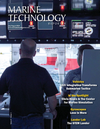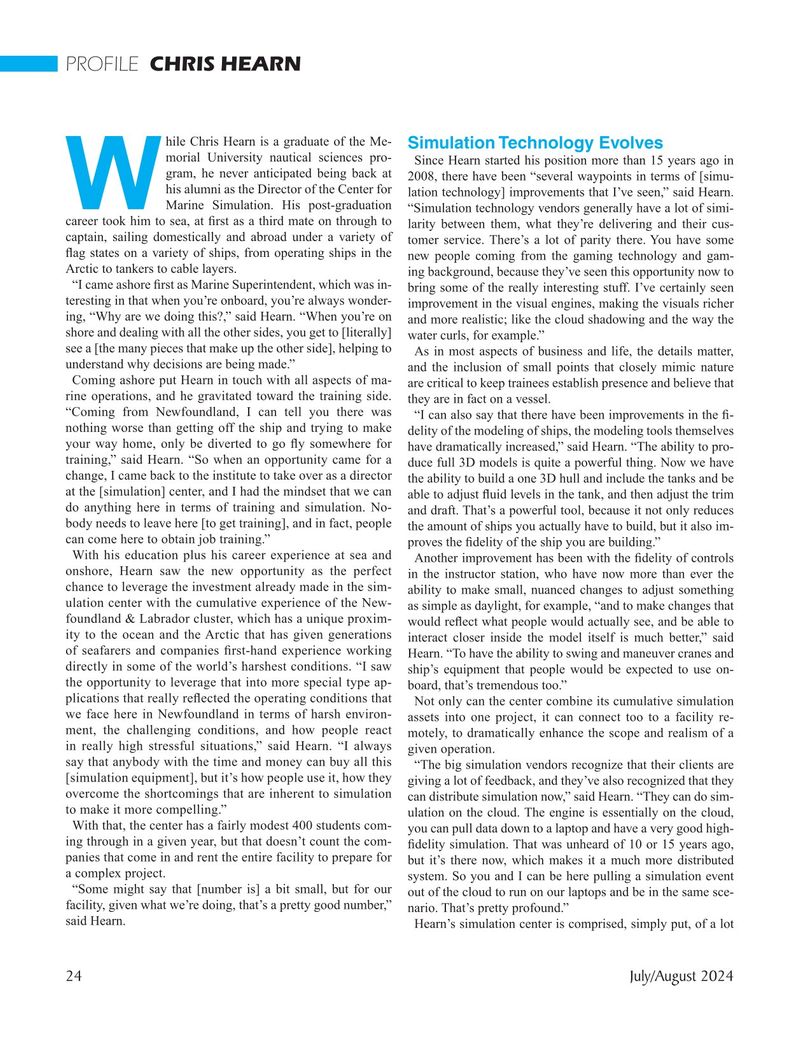
Page 24: of Marine Technology Magazine (July 2024)
Read this page in Pdf, Flash or Html5 edition of July 2024 Marine Technology Magazine
PROFILE CHRIS HEARN hile Chris Hearn is a graduate of the Me-
Simulation Technology Evolves morial University nautical sciences pro-
Since Hearn started his position more than 15 years ago in gram, he never anticipated being back at 2008, there have been “several waypoints in terms of [simu- his alumni as the Director of the Center for lation technology] improvements that I’ve seen,” said Hearn.
W Marine Simulation. His post-graduation “Simulation technology vendors generally have a lot of simi- career took him to sea, at ? rst as a third mate on through to larity between them, what they’re delivering and their cus- captain, sailing domestically and abroad under a variety of tomer service. There’s a lot of parity there. You have some ? ag states on a variety of ships, from operating ships in the new people coming from the gaming technology and gam-
Arctic to tankers to cable layers.
ing background, because they’ve seen this opportunity now to “I came ashore ? rst as Marine Superintendent, which was in- bring some of the really interesting stuff. I’ve certainly seen teresting in that when you’re onboard, you’re always wonder- improvement in the visual engines, making the visuals richer ing, “Why are we doing this?,” said Hearn. “When you’re on and more realistic; like the cloud shadowing and the way the shore and dealing with all the other sides, you get to [literally] water curls, for example.” see a [the many pieces that make up the other side], helping to
As in most aspects of business and life, the details matter, understand why decisions are being made.” and the inclusion of small points that closely mimic nature
Coming ashore put Hearn in touch with all aspects of ma- are critical to keep trainees establish presence and believe that rine operations, and he gravitated toward the training side. they are in fact on a vessel.
“Coming from Newfoundland, I can tell you there was “I can also say that there have been improvements in the ? - nothing worse than getting off the ship and trying to make delity of the modeling of ships, the modeling tools themselves your way home, only be diverted to go ? y somewhere for have dramatically increased,” said Hearn. “The ability to pro- training,” said Hearn. “So when an opportunity came for a duce full 3D models is quite a powerful thing. Now we have change, I came back to the institute to take over as a director the ability to build a one 3D hull and include the tanks and be at the [simulation] center, and I had the mindset that we can able to adjust ? uid levels in the tank, and then adjust the trim do anything here in terms of training and simulation. No- and draft. That’s a powerful tool, because it not only reduces body needs to leave here [to get training], and in fact, people the amount of ships you actually have to build, but it also im- can come here to obtain job training.” proves the ? delity of the ship you are building.”
With his education plus his career experience at sea and
Another improvement has been with the ? delity of controls onshore, Hearn saw the new opportunity as the perfect in the instructor station, who have now more than ever the chance to leverage the investment already made in the sim- ability to make small, nuanced changes to adjust something ulation center with the cumulative experience of the New- as simple as daylight, for example, “and to make changes that foundland & Labrador cluster, which has a unique proxim- would re? ect what people would actually see, and be able to ity to the ocean and the Arctic that has given generations interact closer inside the model itself is much better,” said of seafarers and companies ? rst-hand experience working Hearn. “To have the ability to swing and maneuver cranes and directly in some of the world’s harshest conditions. “I saw ship’s equipment that people would be expected to use on- the opportunity to leverage that into more special type ap- board, that’s tremendous too.” plications that really re? ected the operating conditions that
Not only can the center combine its cumulative simulation we face here in Newfoundland in terms of harsh environ- assets into one project, it can connect too to a facility re- ment, the challenging conditions, and how people react motely, to dramatically enhance the scope and realism of a in really high stressful situations,” said Hearn. “I always given operation.
say that anybody with the time and money can buy all this “The big simulation vendors recognize that their clients are [simulation equipment], but it’s how people use it, how they giving a lot of feedback, and they’ve also recognized that they overcome the shortcomings that are inherent to simulation can distribute simulation now,” said Hearn. “They can do sim- to make it more compelling.” ulation on the cloud. The engine is essentially on the cloud,
With that, the center has a fairly modest 400 students com- you can pull data down to a laptop and have a very good high- ing through in a given year, but that doesn’t count the com- ? delity simulation. That was unheard of 10 or 15 years ago, panies that come in and rent the entire facility to prepare for but it’s there now, which makes it a much more distributed a complex project.
system. So you and I can be here pulling a simulation event “Some might say that [number is] a bit small, but for our out of the cloud to run on our laptops and be in the same sce- facility, given what we’re doing, that’s a pretty good number,” nario. That’s pretty profound.” said Hearn.
Hearn’s simulation center is comprised, simply put, of a lot 24 July/August 2024
MTR #5 (18-33).indd 24 7/23/2024 1:54:48 PM

 23
23

 25
25
